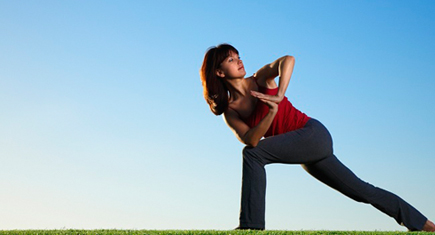Three Top Yoga Positions for Getting Back to the Mat
 For cleansing the body, mind, and soul, many people practice yoga as their primary means of exercise. While on the outset it may not look at strenuous or intense as a run on the treadmill or weight lifting, yoga can be quite a workout. A centuries old discipline that works to strengthen mental and physical wellness, yoga is a versatile and adaptable method for improving flexibility, concentration, and mood. You don’t have to observe any particular religion to enjoy a session at a yoga studio, and you have concerns about enrolling in a class you’ll be happy to know it is a practice that is equally effective when you do it at home.
For cleansing the body, mind, and soul, many people practice yoga as their primary means of exercise. While on the outset it may not look at strenuous or intense as a run on the treadmill or weight lifting, yoga can be quite a workout. A centuries old discipline that works to strengthen mental and physical wellness, yoga is a versatile and adaptable method for improving flexibility, concentration, and mood. You don’t have to observe any particular religion to enjoy a session at a yoga studio, and you have concerns about enrolling in a class you’ll be happy to know it is a practice that is equally effective when you do it at home.
One important thing to know before you begin any type of yoga is that it’s called “practice” for a reason: don’t assume that because you can’t lift your leg high and wrap it around your neck that aren’t good at it. Yoga allows you to stretch and meditate at your speed, and in time you’ll find your body does improve as you learn to breathe and move. Loose-fitting clothing should be worn to keep your skin breathing easily, and you should use a mat for proper posing. Don’t be discouraged if you find you must use supplemental objects like a belt or yoga brick to complete certain poses – yoga should not hurt! Adaptation is the key to wellness here, and as you do more you may eventually no longer need those items.
Whether you are new to yoga, or practice once before and have been “off the mat” for some time, it’s good to begin with the most basic positions to ease your body into a routine. Breathing is one key to ensuring you get the most out of your practice – deeply in and out through the nose to bring oxygen to all parts of the body as you stretch. Three poses, or asanas, used often in basic classes include the Mountain, the Cat, and the Standing Forward Fold.
The Cat: A common pose used during a sequence of forward bends and ground positions, the Cat stretches the middle to upper back and helps strengthen the shoulders. Here, you will start on your hands and knees with your head hanging, then tuck in your tail bone as you round your spine and stretch upward like a cat. Breathe and hold the position for six to eight breaths before slowly coming down to a straightened spine.
The Mountain: This foundation pose works to maintain balance. You still stand tall with your feet the same width as your hips, but your knees will not lock. Starting with your arms at your sides, you will inhale first to stretch your body from your head first, feeling your spine lengthen and straighten, the exhale to stretch your hands toward the floor. In one variation, you will inhale as you lift your arms and reach for the sky with your palms facing inward, breath and hold for about six to eight breaths, then lower your arms on the final exhale.
The Forward Bend: How far you can initially bend will depend upon the flexibility of your body. If you cannot bend fully, don’t worry! What is important is that you exhale and bend forward at the hips, bending your knees enough so your palms press against the floor. As you breathe and hold the position, you’ll concentrate on straightening your legs before you inhale on the release back to starting Mountain. As you practice more, you may discover your legs are straighter a bit more each time.
Yoga is a discipline one can practice at home with or without a DVD guide, or in a class if you prefer a group setting. As you allow the stretching and breathing techniques to refresh your body and mind, you’ll discover others thing you like to do come easier, whether it’s another type of workout or a favorite puzzle. All you have to do is get off the couch and on the mat!
Kathryn Lively writes about Hampton Roads health issues.

